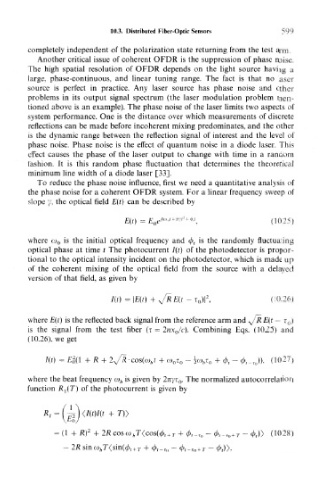Page 615 - Introduction to Information Optics
P. 615
10.3. Distributed Fiber-Optic Sensors 599
completely independent of the polarization state returning from the test arm.
Another critical issue of coherent OFDR is the suppression of phase noise.
The high spatial resolution of OFDR depends on the light source having a
large, phase-continuous, and linear tuning range. The fact is that no laser
source is perfect in practice. Any laser source has phase noise and other
problems in its output signal spectrum (the laser modulation problem men-
tioned above is an example). The phase noise of the laser limits two aspects of
system performance. One is the distance over which measurements of discrete
reflections can be made before incoherent mixing predominates, and the other
is the dynamic range between the reflection signal of interest and the level of
phase noise. Phase noise is the effect of quantum noise in a diode laser. This
effect causes the phase of the laser output to change with time in a random
fashion. It is this random phase fluctuation that determines the theoretical
minimum line width of a diode laser [33].
To reduce the phase noise influence, first we need a quantitative analysis of
the phase noise for a coherent OFDR system. For a linear frequency sweep of
slope y, the optical field E(t) can be described by
j{0i l + 7r; 2
£(0 - E 0e " ' -^'\ (10.25)
where co 0 is the initial optical frequency and (f) t is the randomly fluctuating
optical phase at time t The photocurrent I(t) of the photodetector is propor-
tional to the optical intensity incident on the photodetector, which is made up
of the coherent mixing of the optical field from the source with a delayed
version of that field, as given by
2
/(f) = |£(r) + v/# E(t - T O) , (10.26)
where E(t) is the reflected back signal from the reference arm and ^/R E(t — T O)
is the signal from the test fiber (T = 2nx 0/c). Combining Eqs. (10.25) and
(10.26), we get
/(f) = EO(! + R + 2 X/ R • cos(o) ht + O> OT O — ioj hT 0 + <p t — (/> f _ To )), (10.27)
where the beat frequency co ft is given by 2nji 0. The normalized autocorrelation
function -R,(T) of the photocurrent is given by
2
+ R) + 2/?cosco fc T<cos(0 r + r + <£,_ ro - 0,- to+r - </>,)> (10.28)
2R sinc

